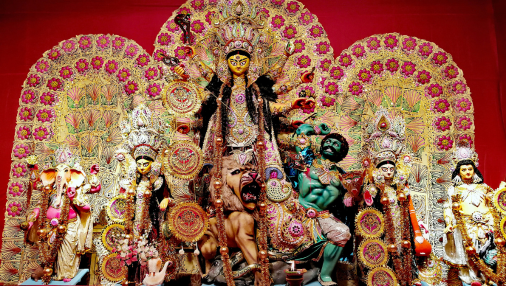What is Ashtami – Significance, Rituals, and Spiritual Meaning
In Hindu tradition, Ashtami marks the eighth day (tithi) of the lunar fortnight and is observed with devotion and a variety of rituals. Some Ashtami days like Durga Ashtami and Krishna Janmashtami are celebrated widely across India and Nepal.
Meaning of Ashtami
The word “Ashtami” comes from the Sanskrit root “Ashta” meaning “eight.” In the Hindu lunar calendar, each month is divided into two fortnights—Shukla Paksha (waxing moon) and Krishna Paksha (waning moon). Ashtami is the eighth tithi (day) of either fortnight. Symbolically, Ashtami represents balance, discipline, and spiritual energy. Ancient scriptures associate the eighth lunar day with divine feminine power (Shakti) and the birth of divine incarnations, making it spiritually significant.
Types of Ashtami
While an Ashtami occurs twice every month, some Ashtamis have special importance:
- Durga Ashtami – The eighth day of Navratri, honoring Goddess Durga in her fierce, warrior aspect. Devotees perform special pujas, havans, and often Kanya Puja (worship of young girls as forms of the Goddess).
- Krishna Janmashtami – Celebrates the birth of Lord Krishna (an avatar of Vishnu) on the Ashtami of Krishna Paksha in the month of Bhadrapada (August–September). Celebrations include midnight puja, bhajans, and fasting.
- Kala Ashtami – Observed every month on Krishna Paksha Ashtami, dedicated to Lord Bhairava (a fierce form of Shiva). Devotees pray for protection from negative forces.
- Maha Ashtami – A central day during Durga Puja especially in eastern India (West Bengal, Assam, Odisha). Rituals like Sandhi Puja and weapon worship are performed.
Common Rituals on Ashtami
Rituals vary by the specific Ashtami and region, but common practices include:
- Fasting (Vrat): Either partial or strict fasts are observed. On Janmashtami, many keep fasts until midnight.
- Chanting and Bhajans: Devotional songs and mantras dedicated to the relevant deity.
- Temple Visits: Large gatherings at temples—especially Krishna temples on Janmashtami and Durga temples during Navratri.
- Altar Decoration: Homes and pandals decorated with flowers, lights, and rangolis.
- Kanya Puja: Worshipping nine young girls as embodiments of the Goddess on Durga Ashtami in many households and communities.
Spiritual Importance of Ashtami
Beyond outward rituals, Ashtami is a time for inner reflection. It’s believed that cosmic energies on the eighth lunar day strengthen prayers, mantras, and meditation. On Durga Ashtami devotees focus on eliminating inner negative traits such as anger and greed, while Janmashtami inspires reflection on virtues of love, righteousness, and devotion taught by Lord Krishna.
Regional Variations
Ashtami celebrations differ across India and Nepal, reflecting regional culture:
- North India: Krishna Janmashtami features Dahi Handi (pot-breaking events) and dramatic Raslila performances depicting Krishna’s life.
- West Bengal: Durga Ashtami is the highlight of Durga Puja with grand pandals, large idols, and cultural programs.
- South India: Janmashtami is marked with kolams (designs) and devotional singing.
- Nepal: Both Durga and Krishna Ashtamis are observed in temples and public processions.
Life Lessons from Ashtami
Ashtami teaches practical and spiritual lessons:
- Discipline and devotion: Observing fasts and rituals cultivates self-control and commitment.
- Victorious spirit: Durga Ashtami reminds us that courage and righteousness can overcome challenges.
- Faith and surrender: Janmashtami highlights the power of faith and devotion to attain inner peace.
- Unity in diversity: Different regional forms of celebration show how a single spiritual idea can unite communities.
Conclusion
Whether observed as Durga Ashtami, Krishna Janmashtami, Kala Ashtami, or Maha Ashtami, Ashtami is a spiritually potent day that combines ritual, reflection, and communal celebration. It reminds devotees to purify the mind, embrace discipline, and celebrate the victory of truth and righteousness. In today's fast-paced life, Ashtami invites us to pause, reflect, and reconnect with deeper values of devotion, courage, and inner balance.

